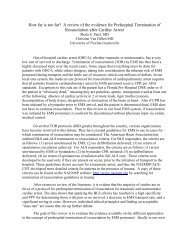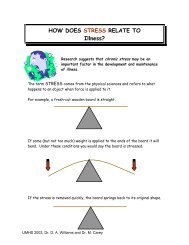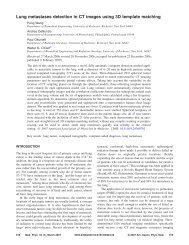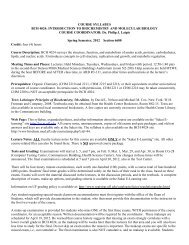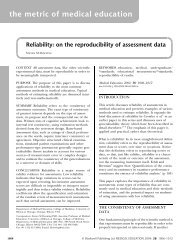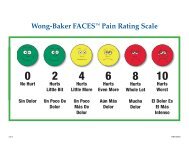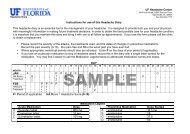Annu. Rev. Biomed. Eng. 2000.2:431-456. Downloaded from arjournals.annualreviews.orgby UNIVERSITY OF ROCHESTER LIBRARY on 07/27/09. For personal use only.?IMAGING 3-D CARDIAC FUNCTION 443canine hearts, that a 3-mm sampling interval through the wall is needed to modeltransmural wall motion in a healthy subject. Less stringent sampling intervals of5–6 mm are needed in the circumferential and longitudinal directions. However, indiseased hearts, in which strong gradients in motion may occur in the border zonebetween healthy and ischemic regions, a higher density of points may be needed.Temporally, some purposes require strain patterns at only a single time point, thatis, from end-diastole to end-systole, to evaluate the strains in the fully contractedstate. However, the evolution of strain may also be critical for clinical diagnosis(62). Strain evolution may give information on the pattern of contraction and revealelectrical conduction pathway abnormalities. This requires the acquisition of dataon a time scale that is smaller than the fastest motions of interest. As suggestedearlier, a temporal resolution limit of 50 ms seems reasonable.One investigational method that has provided valuable research data is the embeddingof arrays of radiopaque markers into the heart wall, which are then imaged byusing biplanar cineradiography. Combining the projection data from two orthogonalviews, one is able to reconstruct the 3-D location of each bead in the array ateach time frame (7). The motion of <strong>three</strong> or more planar beads that are attachedto the surface of the heart give an estimate of the local 2-D surface strain (63, 64).Additional markers at various depths in the heart wall provide the additionalinformation necessary for a complete 3-D motion analysis (65–67). Beads arecommonly arranged in stacks of planar triangles, ∼5 mm on a side, with 4 mm ofseparation between stacks. Imaging a density of beads becomes difficult, but arrayswith 2- to 3-mm separations have been successfully reconstructed. Implanted arraysof sonomicrometers have been used similarly, although their use is generallylimited to 2-D surface studies. The disadvantage of these approaches is the invasivenessof the procedure, which precludes its routine use on human subjects. The implantationsurgery may damage the tissue, the chest wall and pericardium are oftenresected, and the mere presence of several 0.5- to 1-mm-diameter beads through awall 10–15 mm thick may alter the normal mechanical deformations in the subject.An MRI tag is a region of the tissue where the net magnetization has been alteredwith carefully designed radio frequency pulses (3, 68). Upon <strong>imaging</strong>, these alteredregions show good signal contrast compared with neighboring untagged regions.Each tag is created as a 3-D plane that extends through the entire subject, and itis seen as a tag line when imaged in an orthogonal view. Various tag generationschemes have been invented for creating numerous tags in a short amount oftime. The more popular tagging schemes include stacks of parallel lines (69, 70),grids (71), and radial stripes (72). Because the tags result from alterations of themagnetization of the tissue itself, the motion of the tags matches the motion of theunderlying tissue (73, 74).Implanted MarkersMagnetic Resonance Imaging Tagging
444 O’DELL MCCULLOCHAnnu. Rev. Biomed. Eng. 2000.2:431-456. Downloaded from arjournals.annualreviews.orgby UNIVERSITY OF ROCHESTER LIBRARY on 07/27/09. For personal use only.?Strain Rate AnalysisTypically, tags are created at end-diastole when the cavity volumes are largest,and the image data are acquired at 30- to 50-ms intervals as the heart contracts.The altered magnetization persists for ∼0.5 s, based on the T1 magnetizationrelaxation constant of <strong>cardiac</strong> tissue. Therefore, 10–12 images can be acquiredduring the ejection or filling phase of the <strong>cardiac</strong> cycle. The segmentation of tagsis far more easily automated than is the segmentation of the heart contours, becausethe tags are human-made features of the image, for which the location and imageintensity profile can be well predicted (75). The optimal image intensity profileand in-plane separation of tag planes can be computed analytically and have beenvalidated experimentally. For parallel tag data, a tag width of 1–2 pixels with a tagcenter-to-center separation of 6 pixels gives an optimal tag centerline detectionaccuracy (76), which, for a typical image SNR of 15, is



